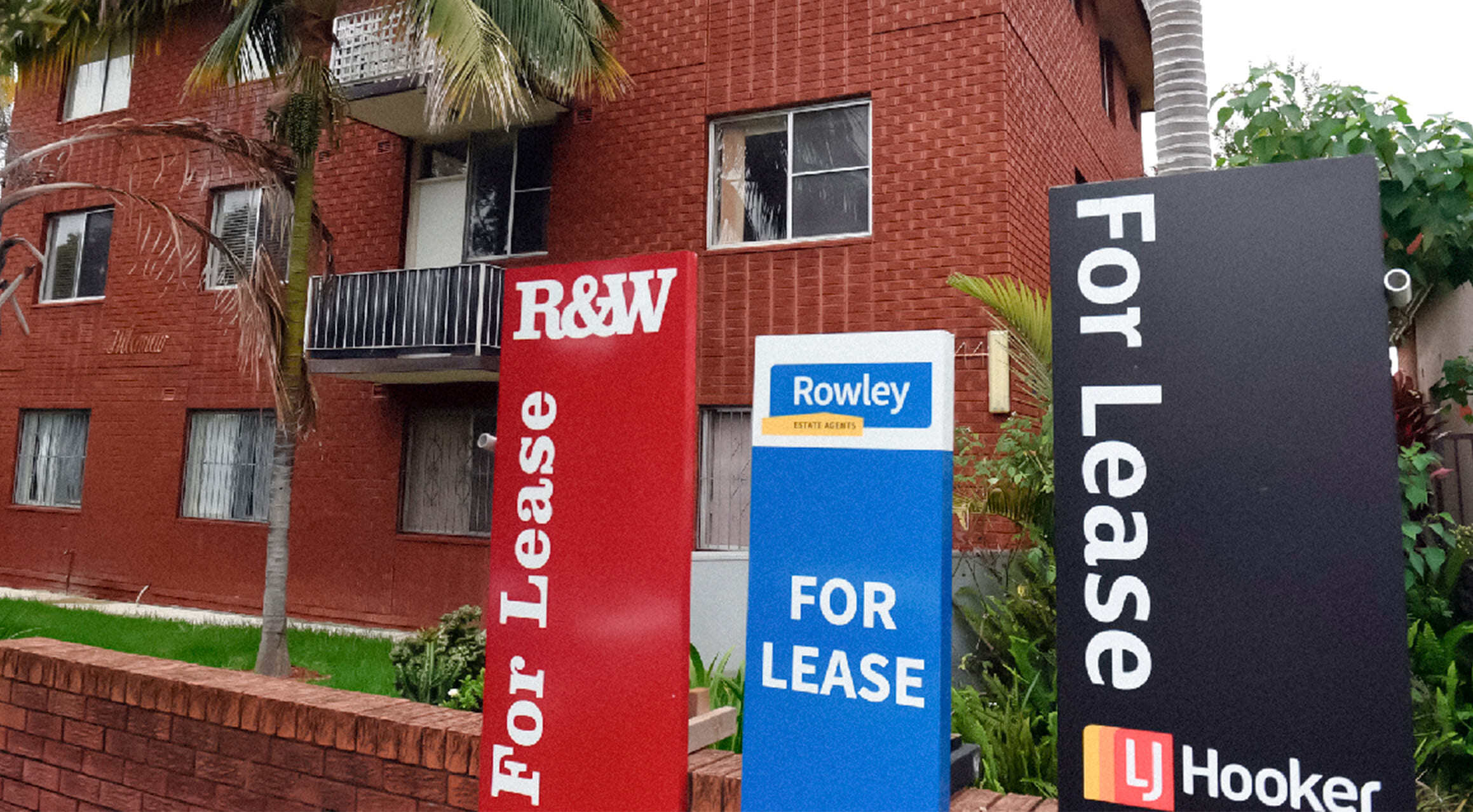Features > Property News & Insights > Housing Trends
PropTrack: Rents remain high, supply of homes for tenants shrinks

Image from Mick Tsikas/AAP
KEY POINTS
- PropTrack says the number of properties available to rent in Australia has fallen to its lowest level since June 2010
- While median national rents were unchanged at $600 a week between the March and June quarters of 2024, they are still 9.1% higher than a year ago
- PropTrack expects rental growth to ease, but with ongoing property shortages and strong population growth, rents will still outpace inflation.
New data from REA Group’s PropTrack shows rents have increased 9.1% nationally since June last year, while the number of properties available to rent in Australia has fallen to its lowest level in 14 years.
The PropTrack Rental Report for June 2024 shows that while there has been a mild easing in the last few months in a very tight rental market, conditions for Australians seeking a home to rent remain extremely tough, and that will continue for the foreseeable future.
PropTrack’s Rental Report is put together using information gleaned from the country’s largest property portal, realestate.com.au, so it provides a comprehensive national snapshot of the state of the market.
The details
PropTrack says the median national rent in Australia remained unchanged over the June quarter of 2024, at $600 per week.
However, that’s still an increase of 9.1%, or $50, on the median rent a year ago.
Over the year to June 2024, rent growth across the capital cities was 10.3%, outpacing regional markets at 8%, with the median weekly rent coming in at $640 across the combined capital cities and $540 in the regions.
There are also fewer properties to choose from, with PropTrack measuring the number of new rental listings on realestate.com.au at 4.7% lower than a year earlier.
That’s the lowest level for the month of June since 2010.
“The lack of new listings coming to market reflects how rental properties are being tightly held by those that already have a rental, as the overall stock of new rental properties is not growing significantly,” the PropTrack Rental Report says.
“This is reflected by most capital city and regional areas having fewer new listings than a year ago and all of them, except for Hobart and Canberra, having fewer new listings than the June average for the decade to 2022.”
PropTrack also measured the national rental vacancy rate at 1.4% in the June quarter of 2024, up from 1.1% in the previous quarter but unchanged when compared to June 2023.
Most analysts say a 3% vacancy rate reflects a “balanced” market, where tenants have a decent range of properties to choose from, while landlords can still expect good rental returns.
So, given the dire shortage of properties and a continuing low vacancy rate (it was around 2.5% in the pre-Covid era), why is rental growth slowing?
Cameron Kusher, PropTrack’s Director of Economic Research and the report’s author, says it “likely reflects the trade-offs that renters are making due to the heightened cost of rent and living.”
“Some of these trade-offs may include renting smaller properties, renting in less desirable locations where rental costs are cheaper or sharing rental accommodation with other tenants.”
PropTrack’s Cameron Kusher says that some prospective tenants are weighing up their options and electing to become homeowners.
“Increased lending activity to first home buyers has seen renters with the means exiting the market to purchase, while increased lending to investors will also likely alleviate some rental pressures.”
“However, a large cohort of renters are unable to leave the rental market and purchase their own home.”
The outlook
“From here, we expect rents will continue to climb, particularly in the major capital cities,” Cameron Kusher says.
“This is due to persistent low supply and strong demand being exacerbated by rapid population growth.”
And while PropTrack predicts rental growth will slow, it’s worth putting that in context.
Before the pandemic, investors could expect annual rental growth of around 2% a year, which was often less than the rate of inflation.
However, that’s changed.
The shortage of rental properties has seen annual rental growth over the last 12 months of more than 9% nationally and above 10% in the capital cities.
Cameron Kusher says he anticipates rents “will continue to outpace the rate of inflation, with rental prices unlikely to stabilise in the short or medium term.”
Stay Up to Date
with the Latest Australian Property News, Insights & Education.




.png?width=292&height=292&name=Copy%20Link%20(1).png)
 SIGN UP FOR FREE NEWSLETTER
SIGN UP FOR FREE NEWSLETTER








.jpg?width=1920&height=1080&name=Warning%2c%20You%20Might%20Be%20Facing%20Higher%20Taxes%20Soon%20(1).jpg)





.png?width=1920&height=1080&name=Rate%20Drops%20Signal%20BIGGEST%20Property%20Boom%20in%20DECADES%20(1).png)

.jpg?width=1920&height=1080&name=Labor%20vs%20Liberal%20These%20Housing%20Policies%20Could%20Change%20the%20Property%20Market%20Forever%20(1).jpg)
.jpg?width=1920&height=1080&name=QLD%20Slashes%20Stamp%20Duty%20Big%20News%20for%20Investors%20%26%20Home%20Buyers%20(1).jpg)
.jpg?width=1920&height=1080&name=Trump%20Just%20Slapped%20Tariffs%20%E2%80%93%20Here%E2%80%99s%20What%20It%20Means%20for%20Australia%20(1).jpg)
.jpg?width=1920&height=1080&name=Federal%20Budget%202025%20More%20Debt%2c%20No%20Housing%20%E2%80%93%20Here%E2%80%99s%20What%20You%20Need%20to%20Know%20(1).jpg)
.jpg?width=1920&height=1080&name=Australias%20Housing%20Crisis%20is%20about%20to%20get%20MUCH%20Worse%20(New%20Data%20Warns).jpg)
%20(1).jpg?width=1920&height=1080&name=Australias%20RENTAL%20CRISIS%20Hits%20ROCK%20BOTTOM!%20(2025%20Update)%20(1).jpg)
%20(1).png?width=1920&height=1080&name=Is%20Adelaide%20Still%20a%20Good%20Property%20Investment%20(2025%20UPDATE)%20(1).png)
.jpg?width=1920&height=1080&name=RBA%20Shocks%20with%20Rate%20Cuts!%20What%E2%80%99s%20Next%20for%20Property%20Investors%20(1).jpg)
%20(1).jpg?width=1920&height=1080&name=I%20Predict%20The%20Feb%20Rate%20Cut%20(My%20Price%20Growth%20Prediction)%20(1).jpg)
.png?width=1920&height=1080&name=Why%20Property%20Prices%20Will%20Rise%20in%202025%20Market%20Predictions%20(1).png)
.jpg?width=1920&height=1080&name=Why%20Investors%20Are%20Choosing%20Apartments%20Over%20Houses%202%20(1).jpg)
.jpg?width=1920&height=1080&name=Why%20Rate%20Cuts%20Will%20Trigger%20A%20Property%20Boom%20(1).jpg)
.jpg?width=1920&height=1080&name=Retire%20On%202Million%20With%20One%20Property%20(Using%20SMSF).jpg)
.jpg?width=1920&height=1080&name=4%20Reasons%20Why%20You%20Should%20Invest%20in%20Melbourne%20Now%20(1).jpg)
%20(1).jpg?width=1920&height=1080&name=Old%20Property%20vs%20New%20Property%20(Facts%20and%20Figures%20Revealed)%20(1).jpg)
%20(1).jpg?width=1920&height=1080&name=Will%20The%20New%20QLD%20Govt%20Create%20a%20Property%20Boom%20or%20Bust%20(My%20Prediction)%20(1).jpg)
%20Scott%20Kuru%20(1).jpg?width=1920&height=1080&name=Inflation%20Hits%20Three-Year%20Low%20(Will%20RBA%20Cut%20Rates%20Soon)%20Scott%20Kuru%20(1).jpg)
.jpg?width=1920&height=1080&name=How%20to%20Buy%20Investment%20Property%20Through%20SMSF_%20The%20Ultimate%20Guide%20(1).jpg)
.jpg?width=1920&height=1080&name=Victoria%20Slashes%20Stamp%20Duty%20Melbourne%20Set%20to%20Boom%20Scott%20Kuru%20(1).jpg)
.png?width=1571&height=861&name=Are%20Foreign%20Buyers%20Really%20Driving%20Up%20Australian%20Property%20Prices%20(1).png)
.jpg?width=1920&height=1080&name=The%20Single%20Factor%20That%20Predicts%20Property%20Growth%20Regions%20(1).jpg)
%20Scott%20Kuru%20(1).jpg?width=1920&height=1080&name=My%20Prediction%20On%20Rates%20%26%20Negative%20Gearing%20(Market%20Crash)%20Scott%20Kuru%20(1).jpg)

-1.png?width=1920&height=1080&name=Major%20Banks%20Cut%20Rates%20Will%20RBA%20Follow%20Suit%20(Sept%20Rate%20Update)-1.png)
%20Scott%20Kuru-1.png?width=1920&height=1080&name=Rate%20Cut%20Coming%20What%20New%20Zealands%20Move%20Means%20for%20Australia%20(Sept%20Prediction)%20Scott%20Kuru-1.png)
%20(1).jpg?width=1920&height=1080&name=Buy%20when%20the%20interest%20rates%20are%20high!%20(Why%20you%20must%20buy%20now!)%20(1).jpg)
.jpg?width=1920&height=1080&name=Carms_Revised%20Taxes%20Due%20Aug%209%20YT%20Thumbnail02%20(1).jpg)
.jpg?width=1920&height=1080&name=Carms_Too%20Little%20Too%20Late%20Aug%207%20YT%20Thumbnail01%20(1).jpg)









.jpg?width=1920&height=1080&name=Carms_Rate%20Drop%20In%20July%20Jun%2010%20YT%20Thumbnail02%20(1).jpg)
.jpg?width=1920&height=1080&name=Carms_Own%20a%20Property%20V6%20Jun%205_YT%20Thumbnail%20(1).jpg)









.png?width=1920&height=1080&name=Artboard%201%20(3).png)






.jpg?width=1920&height=1080&name=YT%20thumbnail%20%20(1).jpg)

